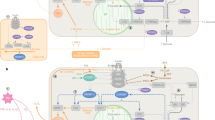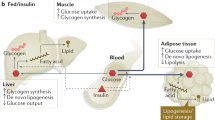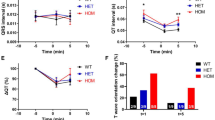Abstract
MAYER and his colleagues first demonstrated the insulin resistance of the mutant obese1 soon after its discovery in 1949. Further work amplified the nature of the resistance: the level of blood glucose was significantly higher, after administration of insulin, than that of normal animals, and it was not possible to put the mutants into an insulin coma or convulsions, even after giving massive doses far in excess of lethal quantities2–4.
This is a preview of subscription content, access via your institution
Access options
Subscribe to this journal
Receive 51 print issues and online access
$199.00 per year
only $3.90 per issue
Buy this article
- Purchase on Springer Link
- Instant access to full article PDF
Prices may be subject to local taxes which are calculated during checkout
Similar content being viewed by others
References
Mayer, J., Bates, M. W., and Dickie, M. M., Science, 113, 746 (1951).
Mayer, J., Andrus, S. B., and Silides, D. J., Endocrinology, 53, 572 (1953).
Shull, K. H., and Mayer, J., Endocrinology, 58, 1 (1956).
Shull, K. H., and Mayer, J., Endocrinology, 58, 220 (1956).
Mayer, J., Physiol. Rev., 33, 472 (1953).
Kennedy, G. C., and Parker, R. A., Lancet, ii, 981 (1963).
Girolamo, M. D., Rudman, D., Malkin, M. F., and Garcia, L. A., Diabetes, 14, 87 (1965).
Author information
Authors and Affiliations
Rights and permissions
About this article
Cite this article
BATT, R., MIALHE, P. Insulin Resistance of the Inherently Obese Mouse—obob. Nature 212, 289–290 (1966). https://doi.org/10.1038/212289a0
Issue Date:
DOI: https://doi.org/10.1038/212289a0
This article is cited by
-
Reduced Adiposity in ob/ob Mice following Total Body Irradiation and Bone Marrow Transplantation
Obesity (2007)
-
The development of insulin resistance in brown adipose tissue may impair the acute cold-induced activation of thermogenesis in genetically obese (ob/ob) mice
Bioscience Reports (1984)
-
The relationship between the hyperplastic pancreatic islet and insulin insensitivity in obesity
Acta Diabetologica Latina (1981)
-
Effects of adrenalectomy on the obese-hyperglycemic syndrome in mice (gene symbolob)
Diabetologia (1973)
-
Pathogenetic aspects of the obese-hyperglycemic syndrome in mice (genotypeobob): II. Extrapancreatic factors
Diabetologia (1970)
Comments
By submitting a comment you agree to abide by our Terms and Community Guidelines. If you find something abusive or that does not comply with our terms or guidelines please flag it as inappropriate.



